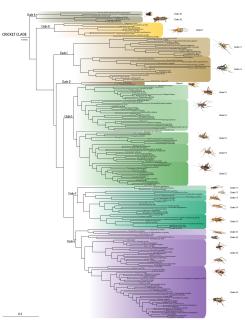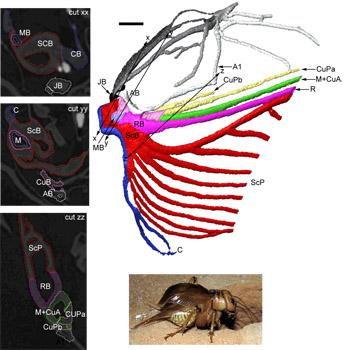
Laure DESUTTER-GRANDCOLAS



45 rue Buffon
CP50
75005 Paris
Polynéoptères
Orthoptera (except Eneopterinae crickets)
La Sonothèque du Muséum national d’Histoire naturelle
MNHN sound Library (with Tony Robillard and Jérôme Sueur)
Rédactrice en chef de Zoosystema, anciennement Bulletin du Muséum national d’Histoire naturelle
Editor-in-chief of Zoosystema, formerly Bulletin du Muséum national d’Histoire naturelle
Collaboratrice pour la base de donnée de connaissances sur Orthoptères Acridomorpha de l’Afrique du Nord Ouest
Collaborator for the knowledge database on Acridomorpha from North West Africa
My research focuses on the evolution of communication modalities and habitats in crickets, and the causal relationships that may exist between these two variables of the biology of species. They are based on observations of non-model species in the natural environment, and use a phylogenetic framework to test evolutionary hypotheses about the origin and changes in species attributes. They involve a significant amount of taxonomy and inventory, since targeted studies in the natural environment lead to the sampling of an often unknown part of the diversity of the clade. Evolutionary hypotheses are tested at the scale of Ensifera, crickets (Grylloidea), or particular cricket clades, depending on the questions.
For the next two years, I will concentrate on the following projects :


Phylogeny of crickets
We built the first molecular phylogeny of crickets (Chintauan-Marquier et al. 2016) using 205 taxa and seven molecular markers : This analysis allowed for the first time to test the few more or less formal morphological studies proposed up now for crickets (Gorochov 1986, Desutter 1987), and to revise the upper taxonomy of crickets. The results supported two superfamilies and six families, ie Gryllotalpidae and Myrmecophilidae (ant-crickets) within Gryllotalpoidea, and Mogoplistidae, Trigonidiidae, Phalangopsidae and Gryllidae within Grylloidea.
This hypothesis will be improved using several complementary sets of data :
Phylogeny of crickets based on 205 terminals and seven DNA markers in Bayesian inference, and derived classification of crickets. The current position of each terminal species in the subfamilies used by the OSF is indicated on the right of the tree. From Chintauan-Marquier et al. 2016. Cladistics 32, Figure 7.

Nervation grillon
X-ray tomography has been used for the first time to study insect wings, especially their very bases, in order to identify the basivenal sclerites and the emergence points of the veins (Desutter-Grandcolas et al. 2017) : these studies allowed to test the various patterns of venation proposed at present and in the past for the clade, and to check vein homologies. For Ensifera, our results show that the stridulatory files present in crickets, mole crickets, katydids and prophalangopsids are not homologous : in crickets and katydids, the stridulatory file is carried by the first anal vein, whereas it is found on different branches of the posterior cubital in molecrickets and prophalangopsids. The resonant surfaces of the elytra also differ according to the clade. These results support a hypothesis of multiple convergence for acoustic evolution in Ensifera.
I am currently checking the venation patterns of all the terminal taxa used in the phylogeny of Chintauan-Marquier et al. (2016), to check for putative apomorphies of cricket families / subfamilies. This will also help to reconsider the many fossil species described as « crickets », and possibly incorporate them in the next future in a global phylogenetic analysis of the Gryllidea, to date the divergence events of the clade.
Similar studies have been performed on Odonata (Jacquelin et al., submit.) and Phasmatodea (Chintauan-Marquier et al., submit.).

The Neotropical Region is particularly rich and diverse for crickets. I began my PhD work there, analyzing in parallel the phylogenetic relationships of taxa and their ecological specialization throughout a succession of forests (Desutter-Grandcolas 1992). This work has resulted in many taxonomic papers, with the descriptions of several dozen of taxa. I resumed this work via collaborations (Desutter-Grandcolas et al., 2014, 2017, Souza-Dias et al., 2014, 2015), but also focusing on the French Guiana (among other opportunities, the « Planète revisitée » Mitaraka Expedition in 2015) and the French West Indies, where an inventory of Orthoptera is underway in collaboration with Sylvain Hugel (Desutter-Grandcolas & Hugel 2016, in prep.). These data are presently analysed in a phylogenetic frame to test the diversification patterns of phalangopsid crickets in the Neotropical Region, and the emergence of convergent ecological syndromes.
In parallel, the Phalangopsidae distributed in the Indian Ocean have been sampled and revised (Desutter-Grandcolas 2015, Desutter-Grandcolas & Felix 2012, Desutter-Grandcolas & Jaiswara 2012), in collaboration with Sylvain Hugel and Ranjana Jaiswara. The taxonomic revision of the Phalangopsidae from the Seychelles, extensively sampled by Sylvain Hugel, and the Comoros are in progress. The analysis of their distributions will be done in 2017 (collaboration with Ben Warren).

The Neocaledonian fauna is highly endemic and dysharmonic (Grandcolas et al., 2008, Nattier et al., 2012), and it hosts a very rich assemblage of original crickets (Grylloidea). 40 genera, 180 species were recorded in 2016 (Desutter-Grandcolas et al., 2016), including 19 genera and more than 90% endemic species in the Territory.
The Nemobiinae (Trigonidiidae) is the most diverse clade in this assemblage, with 11 known genera, nine of which endemic to the Grande Terre. Several genera are strictly straminicolous, while others have more original ecologies, such as Thetella, the “marine” cricket, or Paniella, which lives in mosses on tree trunks. Most species present original morphological characteristics, as Orintia bicornata and its two long parallel horns on the face (Desutter-Grandcolas et al., 2016).
The phylogeny of Chintauan-Marquier et al. (2016), which includes only a part of the Neocalcedonian Nemobiinae, supports two successive colonizations of the island, and at least one episode of subsequent diversification. A more complete phylogeny is currently under reconstruction, to date the successive episodes of colonization of New Caledonia by the Nemobiinae, determine their origin, and analyze the changes of ecological specializations that have occurred during their evolution on the territory.
Le projet INSECT
INSECT est un enseignement modulaire sur la systématique des insectes d’une part, et sur les thématiques scientifiques liées à l’utilisation de modèles insectes d’autre part. Sont abordées aussi bien des questions scientifiques fondamentales que des applications nouvelles liées à des questions sociétales.
INSECT est soutenu par Sorbonne université (appel à projet Forminov2017), Unisciel et le MNHN.
En termes d’apprentissage, cette formation permettra :

Invasion de criquets pélerins, le vieux cauchemar est de retour (2020)
Les insectes, un univers parallèle (mars 2017) - Organes sensoriels et comportements chez les insectes : voir